Some thoughts concerning teaching directions
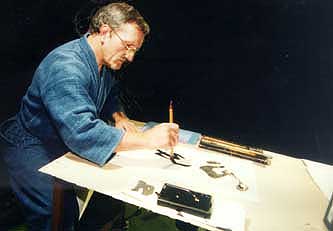
When we find ourselves in a position where we have to transmit, through pre-arranged forms (Kata), a cultural heritage, we are bound to ask ourselves a few questions and get a clear vision of what we are trying to accomplish.
Here is a brief overview of Pascal Kriegerĺs actual convictions: "Shint˘ Mus˘ Ryű J˘ is a Japanese martial tradition some 400 years old. My 30 yearsĺ practice of this Tradition led me to a position, encouraged by Shimizu Sensei, and, at a later date, by Nishioka Sensei, in which I am supposed to promote this classical Bud˘ in the European context. It is a rather difficult task. The main reason, I believe, is that I am not Japanese. I think that the transmission of such a cultural heritage is the sole prerogative of the Japanese people. Indeed, for a Japanese teacher, transmission of heritage may be the only motive for teaching.
As a Westerner therefore, I had to look for other motivations in order to undertake this heavy task. Recently, it became fairly clear to my mind that for us, Westerners, our main motivation to transmit a Japanese martial tradition should be to extract from the spirit of this Tradition all the human values recognized universally. The traditional Japanese values do not concern us directly and are anyway rather inaccessible to Westerners. It is toward this end that I direct my teaching, along with my doubts and errors. In order to give a concrete example of the above, I have chosen the Goj˘ (The Five Conditions).
Originally, this Confucean philosophical concept was promoted in an attempt to harmonize a society divided into Noble men and Men of lower condition. These values were later mis-applied for more corrupted purposes by the Japanese Tokugawa dictature. However, nowadays, it is still possible to find in the spirit of this philosophy some valuable elements that we can apply in our present cultural environment. Moreover, practising J˘d˘ gives us the opportunity to try out this philosophy in our training, and later, in our daily lives. To illustrate my thoughts, et me give you a rapid overview of these five conditions by establishing concrete links with the work in the D˘j˘.
JIN/NIN (Benevolence, Human warmth)
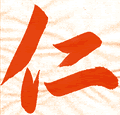
This condition comes first because, if it does not influence the following ones, these may lead to unwanted extremes. In practice, it is an essential value in the relationship between Uchidachi (sword side, thus teaching side) and Shidachi (stick side, thus student side). It is with benevolence, or humility, that the more experienced one shows the way to the less experienced one. Without this main value, the teacher is nothing but a technically advanced person constantly trying to prove to others that he is the best. Relationship between Sempai (seniors) and Kohai (juniors) should reflect the same spirit.
GI (Justice)
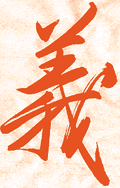
This value is so subjective that it often frightened me. What is right, and according to what? The practice of this value has indeed one important advantage: it forces us to think over before making a decision, even if the decision is proven wrong. In practice, a technique can be correct for a beginner for it helps him in his progression while it proves to be completely illogical in a combat situation. Or it may contain an educative value, or obey safety criteria in case of an intensive training. The teacher must choose, and know what is right, for whom and when, and why, while remaining conscious that his choice may vary under other circumstances. More globally, Justice, when it comes to judge a conflict or solve a problem, requires a solid background and lots of knowledge that only time and experience can give us. While this value is closely related to the "knowledge value", it is important to include in it some JIN/NIN, for Justice can easily lead to opposite extremes. History has proven it many times.
REI (Etiquette)
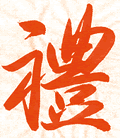
We are living in a period of our history where life landmarks tend to disappear. Particularly in developed countries, people seem to loose interest in ôrights of passageö, as well as rites altogether. When we thoroughly examine the etiquette inherent to the Japanese martial culture, it is very important to think back to the concept of Keiko Sh˘kon: "do not content yourself with simply imitating what has been done in the past, but find in it the spirit that made it so, and apply it in your present environment, social, cultural and philosophical." In practice, the Reishiki tends to ensure that a transition is made between the daily occupations and the work in the D˘j˘ through ritual movements requiring a fair amount of physical and mental concentration. It also encourages the Bud˘ trainee to more consciousness with his weapon, his physical environment, the D˘j˘, and the people with whom he practises. It helps him to get a better understanding of where his right place should be. It is obvious that without JIN/NIN, the etiquette will quickly go back to an obsequious and superficial attitude.
CHI (Knowledge)
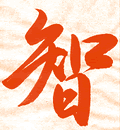
In a period where we tend to stack knowledge rather than construct it, this value is also of great importance. The real knowledge consists in finding the connection between all things that forms a whole and thus acquire a global vision without loosing sight of the details. In practice, the Ri-ai (coherence, logic) of a technique allows us to put this value into practice. Starting from a simple movement, we are first supposed to know all the technical consequences of it, all the possible openings it gives the opponent, then, more deeply, why we execute this movement rather than another, and at that moment. Deeper yet, we must know how this movement is related to the global context of the tradition we follow, and what it is supposed to teach the trainee, to finally comprehend the utility of this movement in the spiritual progression of the practitionner. And all this without forgetting JIN/NIN.
SHIN (Trust)

We are talking here more about the trust we inspire others than acquiring self-confidence. There is also a strong meaning of sincerity imbedded in it. The ideogram underlines this meaning: the radical human followed, on the right, by word: human word. In practice, this value can be double-edged: in case of an attack, the target required by the Kata must be reached or at least aimed at. How many times do we see ourselves cutting beside the target, afraid to hurt the opponent, or too short, or too slow? This attitude does not benefit the opponent because it leads him into the habit of an erroneous technique and distorts his own technique giving him false self-confidence. More globally, this value also means to be on time, to keep oneĺs promises, to do what we have told others we would do, in short, to be worthy of othersĺ trust and to trust others. But here again, History gives us numerous examples of blind trust leading humans to the worst extremes. And here again, JIN/NIN is the best barrier, along with GI, REI and CHI.
It is now sufficiently clear that these five values are closely related and that they form together a whole that could be translated thus: a general attitude that makes us human beings worthy to be considered so.
I specifically chose these five conditions because they are mentionned and underlined in each of the traditional certificates of Shint˘ Mus˘ Ryű J˘.
FÚdÚration EuropÚenne de Jodo / European Jodo Federation